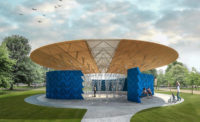Francis Kéré Envisions House of Parliament for Burkina Faso
The award-winning architect, who was born in the West African country, has proposed a dramatic new capitol to replace the former one destroyed during a 2014 revolt.

Diébédo Francis Kéré has conceived a master plan for a parliament complex in Burkina Faso’s capital, Ouagadougou.
Image courtesy Kéré Architecture

Members of the public would be invited to climb up the stepped facades, allowing them to take in elevated views of the city.
Image courtesy Kéré Architecture

Kéré’s design calls for a pyramid-shaped, six-story building made of concrete and stone.
Image courtesy Kéré Architecture

An aerial view of Ouagadougou, where the tallest building is just 11 stories.
Image courtesy Kéré Architecture

Kéré’s proposed design would replace a previous parliament building which was destroyed in 2014 after an uprising.
Image courtesy Kéré Architecture

Inside the destroyed parliament building.
Image courtesy Kéré Architecture

Kéré’s design takes into account local traditions by incorporating a central tree.
Image courtesy Kéré Architecture

The proposed ground floor plan.
Image courtesy Kéré Architecture

The proposed fourth level plan.
Image courtesy Kéré Architecture

Image courtesy Kéré Architecture










In late 2014, citizens of Burkina Faso overthrew the country’s dictatorial leader, President Blaise Compaoré, and set fire to the parliament house, leaving it a charred ruin in the capital city of Ouagadougou. Now Berlin-based architect Diébédo Francis Kéré, who grew up in the West African nation, has conceived a master plan for a new parliament complex.
Kéré says he was informally commissioned to design the project by the new head of the parliament last year and has since been meeting with government officials to push his concept forward. “They say it’s too visionary. I still have to convince them,” Kéré says. “I hope at least some of the ideas will stick.” His scheme is on view at the Architecture Biennale in Venice, which closes November 27.
Rather than replicating Western models, Kéré’s design reflects the values inherent in Burkinabé society. “We can’t keep doing a cheap copy of the West,” he told record. “We have to produce buildings that speak to and inspire our people.”
Kéré’s ambitious design calls for a pyramid-shaped six-story building made of concrete and stone. Members of the public would be invited to climb up the stepped facades, allowing them to take in views of the city. The architect believes such a facility would symbolically engage people in the legislative process in a way that is similar to the forms of governing found in the country’s rural communities. “In a village setting, the decision-making process is not a private matter,” Kéré explains. “Community members are welcome to sit near the gathering of leaders and observe.”
The building also would reflect the agrarian way of life in Burkina Faso, where 80 percent of the labor force is involved in farming, according to a USAID report. The terraced exterior walls would accommodate public garden plots, which would serve as an educational tool to encourage urban farming.
For the interior of the building, the scheme calls for a grand 127-seat assembly hall bordered by a private garden, where parliamentarians could gather for informal interactions. Kéré’s design for the meeting space takes into account local traditions. In Burkinabé villages, elders convene under the shade of a large tree—referred to as arbre à palabres, or tree of discussion—to talk about critical issues.
The master plan also calls for a public plaza, new shops and cafés, and a memorial in the footprint of the old building—a sunken area in the earth that would collect rainwater for on-site irrigation and form a reflecting pool.
While Kéré’s scheme is intended to facilitate an open and peaceful society, he does recognize that civil unrest and terrorist attacks are an ongoing threat. Last January, Islamic militants ambushed a hotel and café, killing more than two dozen people. Mindful of these concerns, Kéré proposes incorporating guarded subterranean tunnels and parking areas for government officials. “In today’s time, we have to deal with security issues. But we also want to provide open access for the public,” he says. “The trick is to find a way to put those two things together.”











